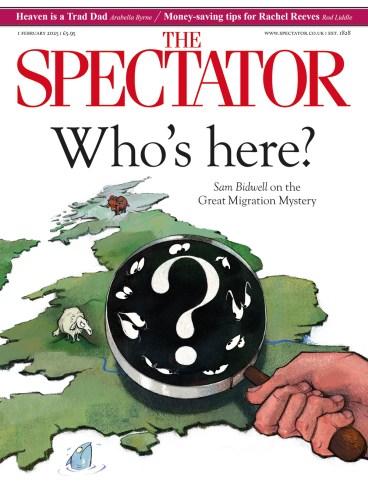
An exhibition of the art of Hélène de Beauvoir (1910-2001), sister of the great Simone, opened in a private gallery near Goodge Street last week. It was the first time Hélène’s work had been shown or received any attention in London, and young people in alternative clothing gathered to sip orange wine and listen, rapt, to the 75-year-old biographer and friend of the de Beauvoir sisters, Claudine Monteil, as her recollections helped elucidate Hélène’s abstract paintings. The reclamation of a new ‘lost’ artist was under way.
De Beauvoir’s cubist self-portrait is quite good – but ‘Simone in red jacket’ must never be seen
It is possible, these days, for gallerists to do good work – self-defining as allies and activists – while making a good fortune. ‘You don’t need to be a Goliath gallery,’ says Amar Singh, 35, the British art entrepreneur behind the show. The process is painstaking, slow and delicate; ‘the whole eco-system has to be right and then the magic happens,’ he says. ‘I’ve set world records a dozen times for overlooked women artists.’
He founded the Amar Gallery in 2017 to specialise, like the Berry Campbell Gallery in New York, in marginalised artists. ‘I salute and love Christine Berry and Martha Campbell. I was watching how they built the global market for these artists, and I was early to start doing it in Europe.’
Singh was the first to show Lynne Drexler in London, just before her prices soared. He included her in his 2017 group show of ab ex women, Hiding In Plain Sight, which coincided with the publication of Mary Gabriel’s brilliant Ninth Street Women – indeed, Singh hosted a party for it – all part of building that ecosystem. Drexler trained under Robert Motherwell and Hans Hofmann in New York, but then withdrew, in 1982, to live a hermit-like existence on Monhegan Island, Maine, occasionally letting a painting go to a passing tourist for $50. Singh sold some small canvases of hers for $5,000 apiece in 2017 and 2018; but in 2022, her 5ft by 7ft work ‘Herbert’s Garden’ (1960) surprised Christie’s New York by selling for $1.5 million; another, ‘Flowered Hundred’ (1962), achieved $1.2 million. Drexler’s estate is now represented by the White Cube. ‘Lynne Drexler is a joyous and painful story for us,’ says Amar. ‘That was probably about $10 million we missed out on, which would have gone towards anti-trafficking initiatives in India that I support as a philanthropist. But it’s ok, perhaps we’ll make it back with Hélène,’ he laughs.
De Beauvoir’s work is already held by the Uffizi and the Pompidou. She is not unknown, and some private collectors hold her work dear. But there is still a long way for her to rise, both in terms of myth and money. There is a genuine public hunger for more remarkable women’s stories and/or art, as well as a sense of the importance of seizing recent history before it vanishes. There is also an art world keen to justify its curatorial choices politically. What the work itself looks like is only part of the package.
De Beauvoir essayed several artistic genres – watercolour, cubism and abstraction, as well as figuration. Whether she makes the genres distinctly her own could be questioned. The internet alas leaves her lesser work laid bare. The cubist self-portrait in the Uffizi is quite good, but ‘Simone in red jacket’ (1986) must never be seen. Her work, appealing in its way, is surely most valuable biographically and historically.
Growing up in Montparnasse during Paris’s prewar heyday, the big sister, Simone, was treated more like a son by their father, while Hélène, two years younger, was free to paint and draw. Simone loved her passionately and protectively, spending half her first annual salary on Hélène’s studio fees and later paying for long-haul flights so Hélène could attend her openings abroad. In 1935, aged 25, Hélène was recruited to the Galerie Jacques Bonjean, co-founded by a young Christian Dior, whose eye was great, naturellement – Leonor Fini, Dali, and Miro also showed there. Marriage to a French diplomat at 32, meant Hélène left the Paris scene, but her work benefitted from living in different countries; deathly conventional watercolour views such as ‘Dans le port’ (c.1950s) were joined by ‘Travailleur du riz’ (‘Rice worker’, c.1940) and ‘Moissonneurs de Maroc’ (‘Women harvesting in Morocco’, 1949). As Monteil said in her talk, Hélène would pre-empt a dismissive or patronising response by signing with a non-gendered ‘H de Beauvoir’ – ‘so they might assume it was Henri’.
When in 1964 Jean-Paul Sartre rejected the Nobel prize for literature, Sartre and Simone escaped from the furore by going to stay at Hélène’s home in Goxwiller in Alsace. Hélène was also a hands-on president of a refuge for battered women there.
After the death of their mother in 1967, the sisters collaborated on ‘La Femme Rompue’ (‘The Woman Destroyed’), a story by Simone based, in part, on the distraught correspondence she received from women abandoned by their husbands. Hélène produced 16 lithographs to accompany the text. Gallimard published only 145 copies of the work, and one of them is on display at the Amar Gallery. ‘I tracked it down at a rare book holding in Zurich. It’s not for sale, there’s not a library in the world that wouldn’t want this book.’ Amar is keeping it to ‘honour and safeguard it’ as a centrepiece in his Hélène de Beauvoir patrimoine.
After les événements of 1968, Hélène produced 30 paintings about the unrest and rebellion. One, titled ‘je t’aime, ah, dis le avec les pavés’ (‘I love you, ah, say it with paving stones’) is a very strong work in oils, with a Philip Guston-like vigour. ‘She was a spirited campaigner like her sister, and she was also playful, she was humorous,’ says Singh, ‘I feel like I know her’. ‘Les Femmes Suffrent, Les Hommes Jugent’ (‘Women Suffer, Men Judge’, 1977), has a sort of Handmaid’s Tale atmosphere, depicting a line of faceless men wearing the red cassocks of authority, pointing at a cowering naked woman. If you had to imagine a work by de Beauvoir sister, this would be it. Singh is organising a show of these figurative works, building her up step by step; for the moment, only her abstract work and watercolours are on sale.
Is the ‘always affectionate’ but sometimes fraught relationship between the sisters visible in some of Hélène’s abstract works? An unnamed oil painting from 1972 presents two orbs, the earth and the moon, perhaps, or are they Simone and Hélène? One is radiant and adoring, the other, the earth, is larger, and more tormented, but they are linked by webs of light, a sort of spectral glue holding them together.
In her old age, living in Goxwiller with her two cats – Siamese and Abyssinian – Hélène fell prey to a charlatan who promised to make her art famous but disappeared with her money and 60 paintings. ‘I am seeing if we can get them logged with the Art Loss Register,’ says Amar, who is in contact with their closest living relatives; neither sister had children. At the time of going to press, half the de Beauvoir show had sold, with watercolours going for £5,000 and oils £20-40,000. ‘The prices won’t stay there for long,’ Amar said. ‘Women are being recognised and re-examined. We are a proper gallery but we try to do good and give back.’








Comments